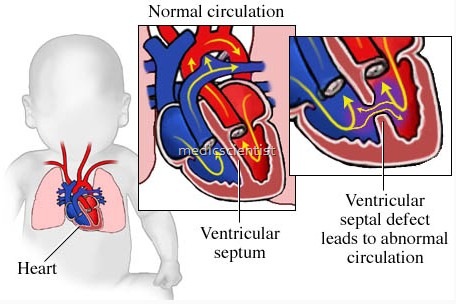CYANOTIC CONGENITAL HEART DISEASE
CYANOTIC CONGENITAL HEART DISEASE means congenital heart disease with cyanosis and clubbing
- Due to high pulmonary vascular resistance in fetus, pulmonary blood flow is very low – only 20% of fetal circulation.
CYANOTIC CONGENITAL HEART DISEASE
A frequently used mnemonic is the “five Ts” of cyanotic CHD:
- Transposition of the great arteries
- Total anomalous pulmonary venous connection
- Tricuspid valve abnormalities
- Tetralogy of Fallot
- Truncus arteriosus
- along with these A sixth “T” is often added for “tons” of other diseases, such as double outlet right ventricle, pulmonary atresia,
Changes in Circulation occurring at birth means congenital heart disease without cyanosis (and without clubbing).
- Pulmonary vascular resistance falls due to expansion of lungs and pulmonary blood flow increases 10 times.
- Ductus venosus closes.
- Placental circulation closes.
- Gas exchange occurs at the lungs and not placenta .
- LA volume and pressure increases due to increased pulmonary arterial blood flow.
- Foramen ovale closes at birth as a LA pressure increases.
- To understand Congenital Heart Disease one must understand fetal circulation.
- There are 2 parallel circulations in the fetus.
- The fetal circulation is not in series.
- There is preferential distribution i.e. blood with higher oxygen saturation goes to brain, and heart; and blood with lower oxygen saturation goes to placenta.
There are 3 extra and important components of fetal circulation.
- Foramen ovale
- Ductus venosus
- Ductus arteriosus .
- Foramen ovale :
- From the right atrium 1/3 of the blood goes into the left atrium through the foramen ovale, then from LA to LV (left ventricle) and then from LV distributed to aorta, coronary and cerebral circulation.
- Ductus venosus:
- Helps to bypass the liver of the fetus so that oxygenated blood from the placenta goes to inferior vena cava and right atrium of the fetus directly.
- Ductus arteriosus:
- Blood with a low 0. saturation enters from the superior vena cava of the fetus to the RA
- RV (right ventricular side)
- pulmonary trunk from the pulmonary trunk, blood mainly enters the ductus arteriosus, from where it is taken via the aorta to the placenta for oxygenation.
- In fetus the pulmonary vascular resistance is high because of :
- Non-inflated lungs
- Pulmonary vasoconstriction because of low oxygen tension.
- RA volume and pressure decreases due to closure of ductus venosus and stoppage of umbilical venous return.
- Ductus arteriosus closes in 1st 48 hours of life. Pulmonary vascular resistance falls low due to release of pulmonary vasodilators and inhibition of pulmonary vasoconstrictors.
- The thickness of right ventricle decreases due to reduction of afterload of right ventricle.
- Left ventricular mass goes on increasing.
Examination of Child with Congenital heart disease
- Physical appearance
- Inspection, palpation, percussion and auscultation of cardiovascular system.
- Arterial pulse
- JVP
- Cyanosis present or absent.
- Which ventricle is dominant? Left or right. (which ventricle is maintaining the circulation).
- Pulmonary arterial blood flow increased or decreased.
- Malformation in left or right side of heart.
- Pulmonary hypertension present or not.


